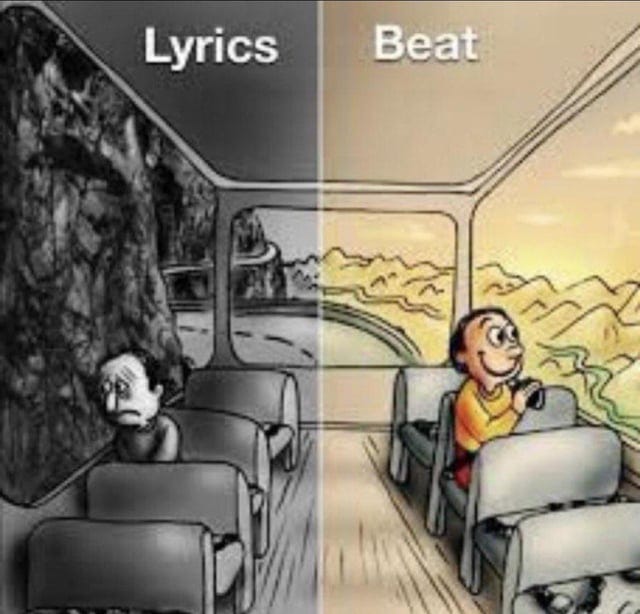A few weeks back a friend at work was talking to me about the music that shaped her life. She, being a Gen Xer in her late '40s, pointed to the funk and soul bands of the 1970s and pop artists of the 1980s. Artists like Tina Turner, Earth, Wind and Fire, James Brown, Billy Joel, Sting, and more helped shape her musical tastes that evolved into the R&B and hip hop of the 1990s and beyond. This conversation really got me thinking: I love so many different types of music, what shaped my musical journey? Let’s unpack it.
Foundational Tones
As a kid I was heavily influenced by the music my parents listened to. We listened mainly to pop music from the ‘80s and a little rock from the ‘70s. When I was around 8-years-old or so I remember getting more into the pop music on the top 40 radio station in town. Hanson, Savage Garden, The Wallflowers, Dave Matthews, and the like were dominating the charts at the time. Meanwhile, my older sister was well on her way down the R&B and hip hop rabbit hole listening to a lot of Biggie, Tupac, Bone Thugs n Harmony, Dru Hill, Faith Evans, and more.
While I liked a lot of what she listened to — remember, R&B was a MASSIVE part of the culture in the mid-to-late ‘90s — I was getting into the pop scene. However, at the same time I was also finding my place in the punk and alternative genres as well. Early Green Day, Oasis, Foo Fighters, Soundgarden, Smashing Pumpkins, and Collective Soul were some of my favorites; but as we continued the march toward the new Millennium, musical trends and the overall cultural aesthetic began to change. The grittiness of post-grunge gave way to the vibrancy of bubblegum pop and the aggression of nu metal. However, there was a short-lived phase that caught my attention in between them that I now realized had a major influence in shaping my love and taste for a wide variety of musical artists and genres.
Don’t want a monthly or annual subscription, but still want to support my work? Share the article with a friend, or leave a donation on Ko-fi!
A (very) brief history of ska
Now I’m not going to pretend I’m an expert on the subject of music history — so I may miss some of the details — but if you aren’t very familiar with ska music, allow me to give you a quick and dirty rundown. Ska was a genre of music that originated in Jamaica in the 1950s and was the progenitor of both the rocksteady and reggae styles of the ‘60s and ‘70s. It found its roots in American blues but had its own very unique sound and feel which, even today, is a major part of American tourism in more tropical beach communities. For your consideration, Guns of Navarone by The Skatalites.
Fast forward to the 1970s and into the ‘80s when 2 Tone, also known as ska revival and ska-rock, hit the UK scene. This blend of traditional ska and the punk rock of the era brought us closer to the ska punk of the ‘90s. For your consideration, Ghost Town by The Specials.
Third wave ska, which includes ska punk, started in the late ‘80s but really blew up in the mid-1990s. Bands like The Mighty Mighty Bosstones, Reel Big Fish, Goldfinger, and more were all over the place. Songs like No Doubt’s Spiderwebs and the Bosstones’ The Impression That I Get performed extremely well on the mainstream charts — reaching #18 and #27 on the Billboard Hot 100, respectively — and for several years ska music was a mainstay of pop culture. Goldfinger’s Superman was featured in the first Tony Hawk Pro Skater game, Less Than Jake collaborated with Kel Thompson on the song We’re All Dudes for the Good Burger movie, The Bosstones’ Someday I Suppose was featured in the generational classic Clueless, and Save Ferris’ I Know appeared in the film 10 Things I Hate About You. No Doubt’s 1995 album, Tragic Kingdom, was also a massive success being certified Diamond by the RIAA having sold 16 million copies by 1999.
For your consideration, one of my personal favorites, All My Best Friends are Metalheads by Less Than Jake.
The Appeal of Ska Punk
So what made third wave ska so popular? Well, record labels and payola most likely, but to me — and many others — it was just plain fun even if some of the songs were pretty dark lyrically (looking at you Sublime). We were coming out of the grunge era and were well into post-grunge. Rap and hip-hop had become increasingly more edgy than it had been in the ‘80s, and while it wasn’t nearly as popular as it is today, it was still a significant force that was shaping the culture. In the midst of all that, ska stood out — to me, at least — as something more fun and unique than much of what else was out there.
Beyond that, ska — and similarly, the swing of the era — were kind of a gateway for many kids and teens to explore musical genres outside what was conventionally popular at the time. While you’ll still find many people who will scoff at the mere mention of ska, I’ve found the ones I talk to don’t even really know why they don’t like it when pressed on the matter. Music journalist Kenneth Partridge fleshes this thought out a bit more thoroughly in his book Hell of a Hat: The Rise of ‘90s Ska and Swing.
“So why this book-length exploration, defense, and celebration of frequently maligned sounds that temporarily captured imaginations in the ’90s? In addition to being vibrant music perfectly suited for those peaceful, prosperous years before 9/11, ska and swing encouraged and rewarded curiosity. If you were passionate about these sounds, there was a universe of great music waiting for you to discover it. Third-wave ska led back to 2 Tone and the Skatalites, plus all the incredible music that’s come out of Jamaica since. Kids who flipped for swing might have gone back to Louis Prima and Cab Calloway and all the other men and women who moved the masses before rock ’n’ roll."
Believe me, we’ll touch on the swing revival in a future article. For now, Partridge continues,
“Swing and ska encouraged young people to actively engage with music, not just sit on the sidelines. You didn’t have to become a mod or a rude boy or fill your house with swanky mid-century furniture. Learning to tie a tie and wearing it while dancing yourself dehydrated at a ska show was enough. Even having the open-mindedness to let a little trombone into your life was something…
“Regardless of whether ’90s ska and swing fans stuck with these genres into the ’00s, they learned from the Bosstones and Royal Crown Revue what it means to interact with pop culture on a deeper level. 'Straight-up rock with a capital R doesn’t ask anything of you,' says Steve Perry of Cherry Poppin’ Daddies. 'But swing and ska do. They’re kind of elitist in a way, because you can’t just roll out of your bed and be into swing and ska. You have to figure it out.'"
Down the Rabbit Hole
For me and most people around at that time, third wave ska was a flash in the pan. While it had been simmering for nearly a decade before it got big, I first heard it on the radio, in movies, and in that Gap khakis commercial toward the end of it’s phenomenal run in the late ‘90s. I was only ten-years-old when I first heard Spiderwebs and The Impression that I Get and I found their upbeat tempos and melodies really set the mood for my childhood. It matched the optimism of the time as we looked forward to the future of the new millennium and that stuck with me over the next several years as I explored my musical interests. Years later, in college, I even discovered a pair of really good Christian ska bands as well: The O.C. Supertones and Five Iron Frenzy. Songs like One Voice and My Evil Plan to Save the World are still among my favorites to this day.
That’s not to say that I stuck with ska long term. Coming from the world of pop and various forms of rock, ska punk broadened my horizons and helped me to have an open mind to other genres. While many of my middle and high school friends were nearly exclusively punks or metal heads, I was dabbling in a little bit of everything. Rock, punk, pop, jazz, swing, orchestral, hip hop, even opera! Just about the only music I wasn’t really into was country, and even then I liked a few songs here and there.
While I liked the horns of ska, and they definitely played a part in developing my tastes, I would attribute to the swing of the time more credit for my current affections to the old-school jazz and big band acts of the past. Rather, the punk-side influences had a much bigger impact on me.
In exploring other artists while using the Listening Stations at our local Sam Goody and watching TRL after school, I found myself drawn to more punk and rock-oriented acts. As time went on I found myself embracing genres like garage rock, hard rock, nu metal, metalcore and the like. Meanwhile, the nu metal exposure helped me to gain a greater appreciation for rap and hip hop as a musical style.
All in all, while ska music wasn’t the most revolutionary genre of our generation, it was a special one in my book. To me, third wave ska — along with the swing revival and even the early days of the 2000s garage rock revival — really encapsulated the sunshine and optimism of that time.
We were growing up in a time of unprecedented technological progress, it was the dawn of Apple’s colorful phase, translucent colorful plastic gadgets were all rage, and Pokemania had swept the country. Perhaps it was just my childish perspective, but with the year 2000 rapidly approaching and growing up in the midst of all of these exciting cultural and technological events, it just seems that ska would be the perfect genre to draw the 20th century to a close.








